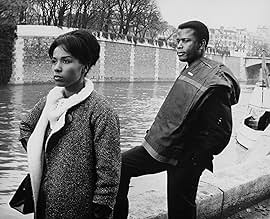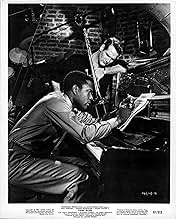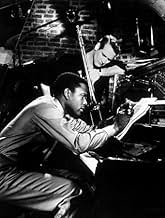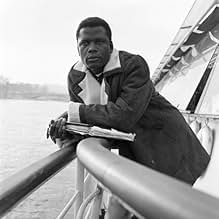NOTE IMDb
6,7/10
4,3 k
MA NOTE
Dans les années 1960, deux musiciens de jazz américains expatriés vivant à Paris rencontrent et tombent amoureux de deux touristes américaines.Dans les années 1960, deux musiciens de jazz américains expatriés vivant à Paris rencontrent et tombent amoureux de deux touristes américaines.Dans les années 1960, deux musiciens de jazz américains expatriés vivant à Paris rencontrent et tombent amoureux de deux touristes américaines.
- Réalisation
- Scénario
- Casting principal
- Nommé pour 1 Oscar
- 2 nominations au total
Guy Pedersen
- Bass Player
- (as Guy Pederson)
Roger Blin
- Guitarist Fausto the Moor
- (non crédité)
Charles Bouillaud
- Luggage Carrier in Train
- (non crédité)
Michel Dacquin
- Guest at Devigne's Party
- (non crédité)
Hélène Dieudonné
- The Pusher
- (non crédité)
Michel Garland
- Club 33 Customer
- (non crédité)
Avis à la une
The American in Paris theme has been done very often in American cinema. The tradition is huge splashy technicolor with Gene Kelly, Fred Astaire, Jane Powell, Audrey Hepburn cavorting around the well known streets and landmarks. Those are nice films, but that ain't what you get here.
No Louvre, no Arc de Triomphe, no Eiffel Tower, a brief shot of Notre Dame from a distance; that's about it from the well known Paris. The Paris we see here in this black and white film is of the jazz clubs of the Left Bank where two expatriate musicians, Paul Newman and Sidney Poitier, eke out a living doing what they love.
Newman has ambitions though, he'd like to be a serious composer not a trombonist all his life. Poitier has come to Paris for reasons of the race problems in the USA.
Into their lives two American tourists come, Joanne Woodward and Diahann Carroll. A couple of dual romances commence.
Carroll and Poitier have a spirited debate over civil rights. The movement is getting into high gear in America and Carroll wants him to return and be part of it. No thanks, says Poitier, he just wants to do his jazz thing where his skin color isn't anyone's problem least of all his own.
Interestingly Carroll was doing a kind of warm up for another part of a black woman in Paris on Broadway the following year in Richard Rodgers, No Strings. In that play she falls for an expatriate writer played by Richard Kiley. An interracial romance, one of the first shown on the Broadway stage, still a lot of the same issues were in that show.
Paris Blues is a different slice of Parisian life for an American film to explore. All four leads do just fine, though the film probably doesn't rank in the top work of any of them.
Lots of jazz music for the aficionado. And of course the presence of the incomparable Louis Armstrong. The highlight of the film is the jam session with those two ersatz musicians Newman and Poitier.
The way Satchmo is received by the public only proves the truth of that line he sang in High Society about the way the French love American jazz.
No Louvre, no Arc de Triomphe, no Eiffel Tower, a brief shot of Notre Dame from a distance; that's about it from the well known Paris. The Paris we see here in this black and white film is of the jazz clubs of the Left Bank where two expatriate musicians, Paul Newman and Sidney Poitier, eke out a living doing what they love.
Newman has ambitions though, he'd like to be a serious composer not a trombonist all his life. Poitier has come to Paris for reasons of the race problems in the USA.
Into their lives two American tourists come, Joanne Woodward and Diahann Carroll. A couple of dual romances commence.
Carroll and Poitier have a spirited debate over civil rights. The movement is getting into high gear in America and Carroll wants him to return and be part of it. No thanks, says Poitier, he just wants to do his jazz thing where his skin color isn't anyone's problem least of all his own.
Interestingly Carroll was doing a kind of warm up for another part of a black woman in Paris on Broadway the following year in Richard Rodgers, No Strings. In that play she falls for an expatriate writer played by Richard Kiley. An interracial romance, one of the first shown on the Broadway stage, still a lot of the same issues were in that show.
Paris Blues is a different slice of Parisian life for an American film to explore. All four leads do just fine, though the film probably doesn't rank in the top work of any of them.
Lots of jazz music for the aficionado. And of course the presence of the incomparable Louis Armstrong. The highlight of the film is the jam session with those two ersatz musicians Newman and Poitier.
The way Satchmo is received by the public only proves the truth of that line he sang in High Society about the way the French love American jazz.
10rps-2
For starters, this is one of those rare movies that would not have been as good if it had been shot in colour. B&W somehow fits the mood, the story and the setting. Yet it's not really a sad or dark story. As in many older B&W films, the lighting is magnificent with highlights and shadows and textures that simply aren't workable in colour. The performances are universally superb. The script is free of the usual clichés. And the music is great. (How could you possibly make a bad movie with the likes of Louis Armstrong, Paul Newman, Joanne Woodward, Sidney Poitier and Diane Carrol?) Nor, in that era (1961), did Hollywood zoom in and linger obsessively on sexual acrobatics. This is a mature, sexy film without any graphic sex. Those were the rules back then and this film is the better for them. A thoroughly enjoyable movie with a great cast that has stood the test of a half century very well indeed.
I read all the other comments regarding this movie, and especially the commentator from Toronto, who stated that the trite clichés of American movies abound in this one; then Green Card and French Kiss were mentioned (Yes, those films WERE awful); The music is excellent; Duke Ellington's music is the backdrop; and Louis Armstrong appears in the film. Sidney Poitier is always right on the mark, sensitive and real; a superb actor. Joanne Woodward and Paul Newman play the ill-fated couple; and do quite well, as has already been mentioned in several reviews. While the story itself is not original, the cinematography is; you will see the street markets; walking along the Seine, Montmartre, Notre Dame, etc. (Compare this to the last big Hollywood film "Moulin Rouge", and I would prefer this film any day!).
This film is to be appreciated for the era it depicts; I have traveled to Europe, and always find that each person's impression is different; Americans who have never traveled unfortunately perpetuate the stereotype; That is sheer ignorance, however. I sincerely hope that all Europeans do not see Americans as portrayed by Meg Ryan, an imbecilic blonde American; or for example, "Le Divorce", with Kate Hudson and Naomi Watts; Please note that Hollywood does NOT represent educated Americans. This is in itself sad, because in the 1960's, when my mother traveled to Europe, I think the world was more friendly; now when even the U.S. is divided into "red" and "blue" states; we are consigned to trash films like "Le Divorce", which Hollywood makes for the lowest common denominator, instead of smaller "art" films which are a pleasant experience.
It is a shame that Hollywood portrays Americans as uncultured imbeciles; this is all about the bottom line (profits). I can honestly say that a real person has not been portrayed by American film blockbusters since the 1970's.
See this film for yourself. It is definitely worth it.
This film is to be appreciated for the era it depicts; I have traveled to Europe, and always find that each person's impression is different; Americans who have never traveled unfortunately perpetuate the stereotype; That is sheer ignorance, however. I sincerely hope that all Europeans do not see Americans as portrayed by Meg Ryan, an imbecilic blonde American; or for example, "Le Divorce", with Kate Hudson and Naomi Watts; Please note that Hollywood does NOT represent educated Americans. This is in itself sad, because in the 1960's, when my mother traveled to Europe, I think the world was more friendly; now when even the U.S. is divided into "red" and "blue" states; we are consigned to trash films like "Le Divorce", which Hollywood makes for the lowest common denominator, instead of smaller "art" films which are a pleasant experience.
It is a shame that Hollywood portrays Americans as uncultured imbeciles; this is all about the bottom line (profits). I can honestly say that a real person has not been portrayed by American film blockbusters since the 1970's.
See this film for yourself. It is definitely worth it.
this movie has been mischaracterized as a fluffy love story, it is not. this film examines racial equality and the differences between France and the us in accepting people of color as more than "help" or as something to fear. this film also touches on the popularity of jazz music, and showcases authentic early jazz as well as painting a picture of the hip jazz subculture, including smoky clubs, late nights and loose women. the film also shows the journey of young musicians trying to find their style and find a place for themselves as jazz composers- not just as musicians. finally, this movie does reflect aspects of a love story- but in examining the film on a deeper level one finds that there really is no love, rather it is a commentary on disconnected, self-indulgent lust. finally - Louis Armstrong appeared and played in the movie- Does it get any better?
Within 2 years of "Paris Blues" being released the US involvement in Vietnam began to sour the relationship between America and la rive gauche. French intellectuals affected to disdain the United States and all its works;one of the few aspects of Americana that were permitted to be still admired was jazz music. Even so the myth of the American jazz musician as a god-like figure had faded by the mid sixties.Giants like Louis Armstrong and Duke Ellington were still revered but the journeymen jazzers like Ram Bowen(Newman)no longer filled the clubs just because they were American. The Indian Summer of America's honeymoon with Europe peaked with "Paris Blues".
Beautifully shot in black and white in the quintessentially Parisian parts of the city where the 2 pairs of lovers could stroll hand in hand photogenically it was a love letter to the arondissements beloved of Scott Fitzgerald,Hemingway and Gertrude Stein 30 years after the affair had ended.
Paul Newman was never more charming,Sidney Poitier never more cool and self-effacing;their pairing considered quite daring at the time coming just a few years after the ground-breaking "The Defiant Ones". Duke Ellington wrote the score and his "Mood Indigo" is beautifully played by Murray McCeachern.Louis Armstrong plays himself - why his character is named Wild Man Moore one can only speculate.
I saw "Paris Blues" when I was 20 years old and my love affair with jazz was a its height. Looking at it now it doesn't seem all that special,the characters and situations have all become clichés;but perhaps that's a bit like saying "Hamlet"'s a good play but it's full of quotations.
Beautifully shot in black and white in the quintessentially Parisian parts of the city where the 2 pairs of lovers could stroll hand in hand photogenically it was a love letter to the arondissements beloved of Scott Fitzgerald,Hemingway and Gertrude Stein 30 years after the affair had ended.
Paul Newman was never more charming,Sidney Poitier never more cool and self-effacing;their pairing considered quite daring at the time coming just a few years after the ground-breaking "The Defiant Ones". Duke Ellington wrote the score and his "Mood Indigo" is beautifully played by Murray McCeachern.Louis Armstrong plays himself - why his character is named Wild Man Moore one can only speculate.
I saw "Paris Blues" when I was 20 years old and my love affair with jazz was a its height. Looking at it now it doesn't seem all that special,the characters and situations have all become clichés;but perhaps that's a bit like saying "Hamlet"'s a good play but it's full of quotations.
Le saviez-vous
- AnecdotesPaul Newman was coached in playing the trombone by Billy Byers, while the playing for Newman on the soundtrack was done by Murray McEachern. Sidney Poitier's tenor sax playing was done by Paul Gonsalves. The soundtrack was recorded May 1-3, 1961 at Reeves Sound Studios in New York City.
- GaffesSome may believe that the mouthpiece ligature on the tenor saxophone that Eddie Cook (Sidney Poitier) plays is upside down. However, in the first scene when the band is playing, it can be seen that the thumbscrew that adjusts the ligature is on the bottom, where it normally would be. It is, therefore, not upside down.
- Crédits fous"Introducing" Serge Reggiani, who by 1961 had been in French films for 20 years and a star at least throughout the 1950s.
- ConnexionsFeatured in A Century of Black Cinema (2003)
- Bandes originalesTake The 'A' Train
(uncredited)
Music by Billy Strayhorn
Recorded at Reeves Sound Studios, New York on May 2 & 3, 1961.
Label - United Artists
Meilleurs choix
Connectez-vous pour évaluer et suivre la liste de favoris afin de recevoir des recommandations personnalisées
- How long is Paris Blues?Alimenté par Alexa
Détails
Box-office
- Montant brut aux États-Unis et au Canada
- 1 300 000 $US
- Durée1 heure 38 minutes
- Couleur
- Rapport de forme
- 1:66
Contribuer à cette page
Suggérer une modification ou ajouter du contenu manquant

Lacune principale
By what name was Paris Blues (1961) officially released in India in English?
Répondre
































